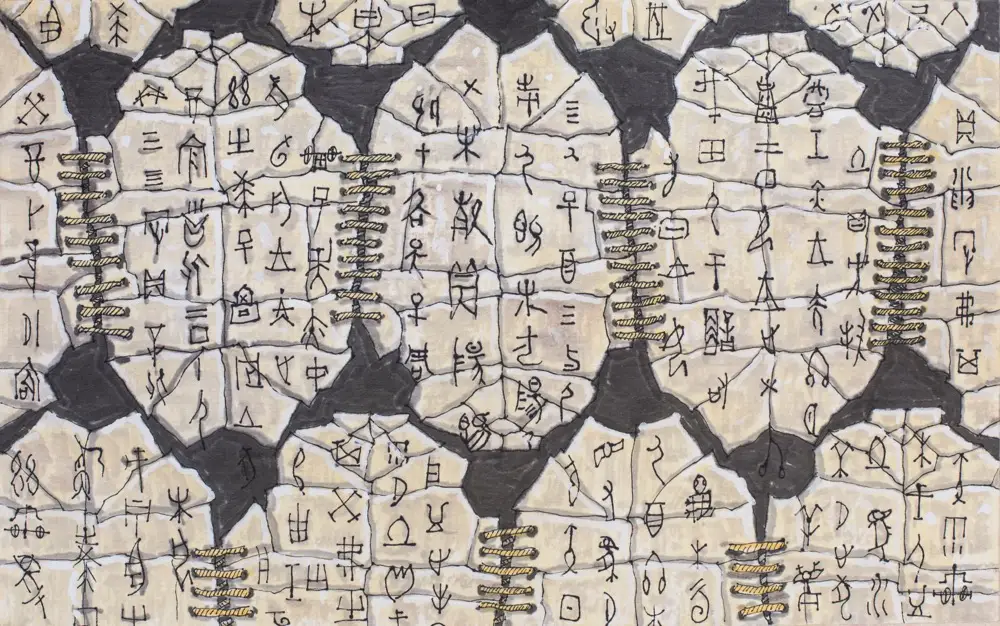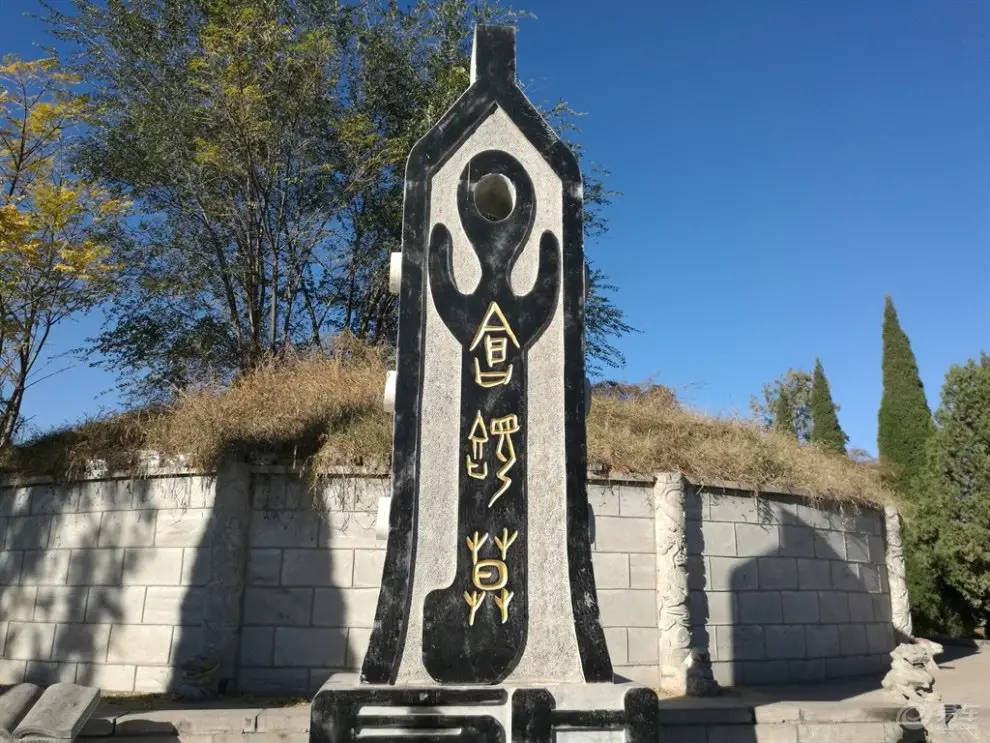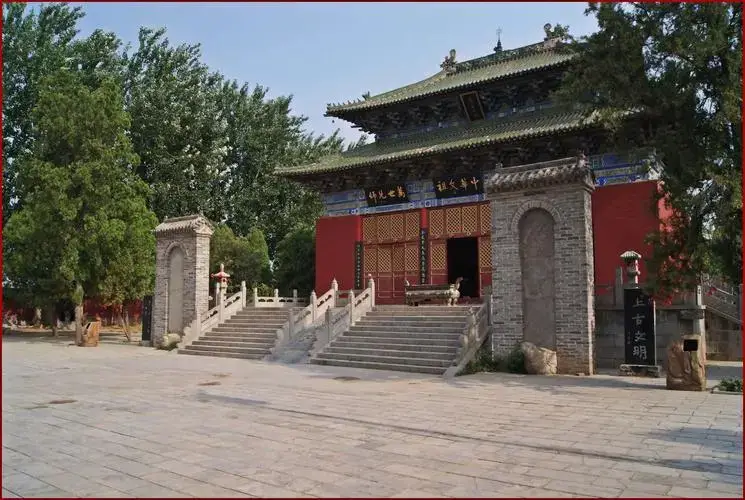According to the ancient Chinese philosophical classic, “Han Feizi,” Cangjie served as the official historiographer for the Yellow Emperor and is credited as the inventor of Chinese characters. The significance of Chinese characters in documenting Chinese civilization is considered invaluable.
Before the invention of writing, ancient people used a method known as “knot tying” to memorize information by tying knots in ropes. Large knots represented significant events, while small knots represented minor details. Later, people began carving symbols onto bamboo to record information. As civilization progressed, tasks became increasingly complex, and these methods no longer sufficed to meet people’s needs. This led to a pressing demand for the development of characters.
Cangjie, under the command of the Yellow Emperor, was determined to create a unique writing system. It is said that his inspiration came from the footprints of animals. A hunter informed him that different footprints represented different animals. Cangjie believed that if he could capture the distinctiveness of every element on Earth in a single representation, writing would become possible.
From that day forward, Cangjie observed everything— the distribution of celestial bodies, the appearance of mountains and rivers on Earth, the tracks of birds, beasts, insects, and fish, and the shapes of plants. He then created different symbols and assigned meanings to each one. Primitive writing was thus invented, with Cangjie likely serving as a representative figure who contributed to the summarization and organization of characters, playing a crucial role in the formation of Chinese characters and forever being remembered as such.
who is cang jie?
Cangjie, a figure in ancient Chinese mythology, is said to have created writing at a place known as the “Phoenix Carrying Letters Platform.” This narrative is found in the “Huainanzi” (淮南子) under the section titled “Basic Principles and Lessons.” The passage states: “In ancient times, Cangjie created writing, and grains fell from the sky, causing ghosts to wail.” Cangjie, also known as Cang Jie or Cangjie, is identified as Hou Gang, with the courtesy name Shi Huangshi. He played a crucial role in collecting, organizing, standardizing, and using the written characters that had been passed down among the ancient people. While it is widely regarded as a legend that Cangjie single-handedly created the Chinese characters, he is acknowledged as a consolidator and organizer of characters, revered by later generations as the “Sage of Writing.”

According to the “Genealogy of Ten Thousand Surnames” (万姓统谱), Cangjie’s place of origin is documented: “In ancient times, Cangjie from Nanle, Wucun, born as a saint with four eyes, observed bird tracks and insect markings, initiating the creation of written characters to replace the governance of knotted cords. He was the historiographer of Yellow Emperor Xuanyuan.” The “Ming Unity Chronicles” (明一统志) also records: “Cangjie, born in Wucun, Nanle, a saint with four eyes, observed bird tracks and insect markings, initiating the creation of written characters to replace the governance of knotted cords. He was the historiographer of Yellow Emperor Xuanyuan.”
Throughout the country, there are numerous relics commemorating Cangjie, such as Cangjie’s creation of characters, the Character-Creating Platform, Cangjie’s Tomb, and Cangjie’s Temple. Among these, there are four places dating back to the Han Dynasty: Nanle in Henan, Yucheng, Kaifeng, and Luonan and Baishui in Shaanxi. Cangjie is said to have created characters by observing bird tracks.
what is cangjie occupation?
Cangjie is a renowned figure in Chinese history, revered as the “Sage of Writing” for his role in creating Chinese characters. According to historical records, he lived during the time of the Yellow Emperor and served as the official historiographer. However, there are varying accounts and debates regarding Cangjie’s specific duties and how he invented Chinese characters.
Firstly, concerning Cangjie’s occupation, the “Shuowen Jiezi” records that Cangjie was the Left Historiographer during the era of the Yellow Emperor. Left Historiographer was a position responsible for recording historical events and compiling historical texts, a prestigious and noble profession in ancient times due to the Chinese tradition of documenting history. This environment provided Cangjie with the conditions and opportunities for creating writing.
Additionally, documents such as the “Shiben” and “Huainanzi” also contain records of Cangjie’s role as a historiographer. These texts suggest that, as a historiographer, Cangjie not only documented history but also managed and preserved historical materials. This facilitated his creation of writing, as he could draw inspiration and material from observing and organizing historical records.
However, there are different accounts and controversies regarding how Cangjie created Chinese characters. According to the “Records of the Grand Historian” (“Shiji”), Cangjie was inspired to create Chinese characters by observing the footprints of birds and animals and the natural scenery. He noticed patterns and characteristics in the footprints of birds and animals and the shapes of mountains and rivers, combining these natural elements with human production and life practices to form the initial Chinese characters.
Another explanation suggests that when Cangjie created Chinese characters, he employed the “Six Methods” approach, incorporating six techniques such as pictograms, ideograms, compound ideographs, phonetic loans, phonetic compounds, and derivative cognates. This method emphasized both the form and meaning of Chinese characters, making them more understandable and memorable.
In conclusion, there are various accounts and debates regarding Cangjie’s occupation and the process of creating Chinese characters. Nevertheless, it is evident that Cangjie, in his esteemed role as a historiographer, had the convenience and opportunity to create Chinese characters. His process involved observing, organizing, and synthesizing natural elements and human practices, employing scientific methods like the “Six Methods.” Chinese characters, as representatives of Chinese culture and a vital carrier of Chinese civilization, were significantly shaped by Cangjie. The process of creating Chinese characters reflects the wisdom and creativity of the Chinese nation, making a substantial contribution to the development of human civilization.
why cang jie invented the Characters?
Cangjie’s creation of writing stemmed from a multifaceted interplay of external influences and internal motivations. Here is a detailed analysis of the reasons behind Cangjie’s invention of writing:
Firstly, from an external perspective, Cangjie lived in an era devoid of a written language. As society progressed and humanity advanced, there arose a need to record and transmit information, facilitating the exchange of ideas in production, life, and culture. However, there was no existing written system at the time that could fulfill this need. Consequently, the urgent societal demand for a simple and effective writing system capable of expressing complex thoughts served as the external impetus for Cangjie to create writing.

Secondly, as the historiographer for the Yellow Emperor, Cangjie bore the responsibility of recording history and preserving culture. The duties of a historiographer required him to document historical events, cultural knowledge, and societal interactions for the purpose of passing them down to future generations. Without a written language, these records relied on oral transmission or simple symbolic markings, methods that were not only prone to inaccuracies and incompleteness but also struggled to endure over time. To better fulfill his duties as a historiographer, Cangjie realized the necessity of creating a written language that could accurately and comprehensively record and transmit history and culture.
Thirdly, Cangjie’s personal pursuit of knowledge and innovative spirit played a significant role in driving him to create writing. Historical records depict Cangjie as an intelligent and inquisitive individual with a keen observational and contemplative nature. His broad understanding of natural and societal phenomena compelled him to continually explore and invent new written symbols, aiming to express more nuanced and profound intellectual content.
Fourthly, Cangjie’s creation of writing also responded to the need to enhance productivity and foster societal development. In ancient societies, the creation of writing was considered a culturally significant phenomenon with sacred implications. Writing not only recorded history and culture but also played a pivotal role in advancing commercial trade, political governance, and social administration. Therefore, creating writing held paramount significance in improving productivity and promoting societal progress. Through the invention of writing, Cangjie not only met societal demands but also made a substantial contribution to the advancement of human civilization.
In conclusion, Cangjie’s creation of writing was influenced by a multitude of factors. External demands, the responsibilities of a historiographer, his intrinsic thirst for knowledge and innovative spirit, and the imperative to enhance productivity and stimulate societal development collectively motivated him to continually explore and create new written symbols. Cangjie’s creativity and wisdom not only contributed significantly to the development of the Chinese nation but also left an indelible mark on the broader history of human civilization.
how cangjie invented to characters in china?
Legend has it that Cangjie was born with “double pupils and four eyes.” In Chinese historical records, only nine individuals were noted to have double pupils, including Yu Shun, Cangjie, Xiang Yu, Chong Er, Gao Yang, Lü Guang, Yu Julo, Guan Yu, and Li Yu. According to the legend, Cangjie “initiated the creation of written characters to replace the use of knotted cords.” Before this, people used knotted cords for record-keeping, using large knots for significant events and small knots for minor matters, connected by a series of interlinked knots. Later, they progressed to using knives to carve symbols on bamboo and wood for record-keeping. As civilization advanced, matters became more intricate, encompassing numerous names and objects. The methods of knotting and wood carving were insufficient to meet the growing needs, prompting an urgent demand for the creation of a written language.
During the time of the Yellow Emperor, an era marked by numerous inventions, such as silk cultivation, boats, chariots, bows, mirrors, cooking pots, and steamers, Cangjie was determined to create a written language inspired by the advancements of the period. One year, while on a southern expedition, Cangjie drew inspiration from the “hoofprints of sheep and horses.” With ceaseless contemplation and observations of the distribution of stars in the sky, the terrain of mountains and rivers, traces of birds, beasts, insects, and fish, as well as the shapes of plants and tools, Cangjie meticulously created various symbols. He assigned specific meanings to each symbol, creating a system to represent the myriad things in the world. He named these symbols “characters” or “words.”
According to the legend, Cangjie, relying on the records of knotted cords, provided the Yellow Emperor with inaccurate historical facts, resulting in the Yellow Emperor’s defeat in negotiations with the Flame Emperor at the border. Filled with remorse, Cangjie resigned from his official position, embarking on a journey to seek better methods of recording historical events. Three years later, he returned to his hometown in Yangwu Village, Baishui, and, through deep observation of the constellations and animal tracks, organized the gathered materials to create various symbols. He named these symbols “characters” or “words.”
The legend further tells of a peculiar event when Cangjie successfully created the characters. On that day, grains fell from the sky like rain, and at night, eerie cries and wails were heard. The falling grains were considered a celestial celebration of the creation of writing, but the cries of ghosts were interpreted as a premonition of the challenges that would arise due to the misuse of the written language, leading to deceit, competition, and violence in society.
It’s also said that after Cangjie successfully created the characters, something strange happened. On that day, grains fell from the sky like rain, and at night, eerie cries and wails were heard. The falling grains were considered a celestial celebration of the creation of writing, but the cries of ghosts were interpreted as a premonition of the challenges that would arise due to the misuse of the written language, leading to deceit, competition, and violence in society.
There’s another version of the story that suggests after Cangjie successfully created the characters, something strange happened. On that day, grains fell from the sky like rain, and at night, eerie cries and wails were heard. The falling grains were considered a celestial celebration of the creation of writing, but the cries of ghosts were interpreted as a premonition of the challenges that would arise due to the misuse of the written language, leading to deceit, competition, and violence in society.
Regardless of the version, the creation of writing by Cangjie is considered a monumental achievement in Chinese culture, allowing the recording and transmission of knowledge throughout generations. The legend emphasizes the significance and responsibility associated with the creation of written language and the potential consequences of its misuse.
Cangjie’s creation of writing is a widely circulated legend throughout the country. “Huainanzi · Benjing Xun” records, “In ancient times, Cangjie created writing, and grains fell from the sky while ghosts cried at night.” The preface of “Shuowen Jiezi” states, “Cangjie, the historian of the Yellow Emperor, observed the traces of birds and animals’ hooves and claws, understanding the distinctions that could be made now. He constructed written agreements.” Due to Cangjie’s significant contribution to the creation of writing, legends and traces related to Cangjie’s creation of writing are found in many places along the middle and lower reaches of the Yellow River. Among them, Dong’er Village in Linfen, particularly in the current Zhaocun of Yaomiao Town, has a more widespread influence. It is said that since the Han and Tang dynasties, there has been a Cangjie Shrine in the village, known as the “Cangjie Holy Shrine,” where annual spring sacrifices are conducted. The shrine has over 400 rooms, divided into a Chongwen Guild Hall and a Peiying Yizhuang on either side, with township-level imperial examinations held here.
Cangjie’s Tomb in Nanle
Cangjie’s Tomb is located in Nanle County, Henan Province, originally named Cangjie Temple, situated near Wu Village in the northwest of the county. It was first built in the second year of Yongxing in the Eastern Han Dynasty (154 AD). After several reconstructions, a devastating event in 1966 left the temple in ruins, with Cangjie’s tomb excavated, revealing numerous artifacts from the Longshan and Yangshao periods. The temple still houses two ancient steles: one from the Yuan Dynasty with a partial inscription stating, “Cangjie was born and buried here, illuminating the people of the city,” and the other stele from the Northern Song Dynasty with an inscription left by the renowned statesman Kou Zhun during his visit to Cangjie Temple: “The land of Pan Gu’s cultural achievements, the home of a sage who opened the heavens.” On the west side of the tomb, there is a temple built in the second year of Yongxing in the Eastern Han Dynasty (154 AD), part of a grand architectural complex that was severely damaged during the Cultural Revolution. On September 25, 2000, the People’s Government of Henan Province declared it a provincial-level key cultural relic protection unit.

Regarding Cangjie’s burial site, historical records provide various accounts. The “Chantongji” mentions, “Cangjie lived in Yangwu and was buried in Lixiang.” The “Bianjing Yiji Zhi” from the Ming Dynasty records, “Cangjie’s tomb is in Shihetian and Bao.” A damaged stele from the Yuan Dynasty in Nanle County carries the inscription, “Cangjie was born and buried here, illuminating the people of the city.”
Baishui Cangjie Temple
Cangjie Temple is built to commemorate Cangjie, the originator of writing. Cangjie served as the historiographer for the Yellow Emperor and is credited as the creator of Chinese characters. The main components of Cangjie Temple include the mountain gate, east and west theater buildings, front hall, lecture hall, middle hall, sleeping hall, bell and drum towers, and east and west wing rooms. The main hall was constructed during the Yuan Dynasty, with a beam made of Artemisia wood, measuring 16 meters in length, 55 centimeters in thickness, and having a uniform straight structure, a rarity in the world. The front hall, offering hall, theater building, clock tower, and drum tower were restored during the Republic of China period. Inside the temple are 19 ancient murals and dozens of inscriptions from various dynasties. Over 40 ancient cypresses, estimated to be over a thousand years old, surround the temple and tomb, adding to the historical and cultural significance. The ancient cypresses of Cangjie Temple constitute one of the three major ancient cypress groups in China, surpassing those in Qufu’s Confucius Temple and the cypresses at the Yellow Emperor’s Mausoleum in terms of age, making it the foremost group in the country.

Baishui Cangjie Temple has a long history, with documented temple records dating back over 1800 years to the Eastern Han Dynasty. According to historical records, efforts to establish the temple began during the Yongxi period of the Eastern Han Dynasty, forming a considerable scale. Consequently, there is a documented temple history spanning 1800 years. Unrecorded history, according to folklore, can be traced back to the era of the Yellow Emperor.
Cangjie creating characters meaning
Farewell to the era of “knotting records”: In ancient China, there are records of methods such as “knotting records” and “engraving on wood” in early texts. These were common methods for record-keeping, but unfortunately, the materials used were not durable, making it impossible to ascertain the specifics of the record-keeping practices at that time. However, the discovery of 150,000 oracle bone inscriptions in Xiaotun, Anyang, with well-preserved characters on turtle shells and ox scapulae, totaling around 3,500 characters, provides valuable insights. In terms of the structure of oracle bone inscriptions, advanced character construction methods such as pictograms, phonetics, semantics, and loan characters were widely applied, indicating a relatively sophisticated system in the Shang Dynasty over 3,000 years ago. This suggests a longer developmental process before this period.
Archaeological discoveries demonstrate that ancient Chinese ancestors were carving symbols on turtle shells as early as 7,000 to 8,000 years ago. In the Yangshao and Dawenkou cultures dating back 5,000 to 6,000 years, symbols carved on pottery, some resembling characters found on oracle bones, were discovered. The presence of red inscriptions on early Dragon Culture pottery dating back over 4,000 years confirms the existence of writing in China for at least four millennia. The emergence of writing is a result of continuous accumulation and summarization in long-term social life. Therefore, Cangjie likely played a role in organizing and summarizing these characters, contributing to the formation of Chinese characters.
This prehistoric legendary figure is not mentioned in ancient Chinese texts before the Warring States period. The earliest mention of Cangjie comes from the Warring States period with Xun Qing. Subsequently, records in “Lu’s Spring and Autumn Annals” and “Han Feizi,” based on Xunzi’s statement that “many people love books, but only Cangjie passed it down, only one,” further extended the narrative. The main viewpoint is that “Cangjie created writing.” After the Han Dynasty, in “Huainanzi” and “Lunheng,” the narrative evolved from “Cangjie creating characters” to “Cangjie with four eyes,” taking on a more mythological aspect. Particularly in the Han dynasty’s “Weishu,” the narrative further exaggerated Cangjie’s abilities, stating that he “was born with the ability to write, received the River Chart, observed the changes in heaven and earth, and created characters by looking up at the stars and examining the patterns of fish, birds, mountains, and rivers.” Over time, the legend continued to develop, portraying Cangjie as the “historiographer of the Yellow Emperor” and other extraordinary roles. The Yellow Emperor was one of the leaders of a late primitive tribal alliance, and during that time, there was no state apparatus. The use of the term “historiographer” for a prehistoric legendary figure is an application of later official titles to figures from prehistoric legends.
The legend of “Cangjie creating characters” was already widely circulated during the Warring States period. “Huainanzi · Benjing” records: “In ancient times, Cangjie created characters, and grains fell from the sky while ghosts cried at night.” The preface of “Shuowen Jiezi” states: “At the beginning of Cangjie’s creation of characters, it was based on imitating forms and shapes, hence called ‘wen’ (script); later, with the progress of phono-semantic compounds, associative compounds, and phonetic borrowing, it was then called ‘zi’ (character).”
Zhang Yanyuan’s “Records of Famous Paintings through the Ages · Origin and Development of Painting” explains: “Cangjie had four eyes and observed celestial phenomena. He followed the traces of tortoises and saw the patterns. Unable to hide the secrets of creation, it rained grains; unable to escape its form, ghosts cried at night. At that time, painting and writing were not yet distinguished, and the shaping was just beginning to be outlined. The intention was passed down through characters because there was no other way to convey it, and painting emerged because there was no other way to show its form – the intentions of heaven, earth, and sages.”
The story of Cangjie
The birth of Chinese characters was not the work of a single individual but the result of long-term accumulation and development by ancient people. Modern archaeology has unearthed oracle bone inscriptions from the Shang Dynasty over 3600 years ago, pottery inscriptions from around 4000 to 7000 years ago, and turtle bone inscriptions with symbolic carvings from around 7000 to 10,000 years ago. The enduring legend of Cangjie’s creation of characters suggests that he made significant contributions to the development of Chinese characters, possibly playing a role as the compiler and summarizer of characters.
There is another mythical legend in history about Cangjie’s role as the historiographer of the Yellow Emperor. After the unification of the Huaxia region by the Yellow Emperor, he found that the method of using knotted cords for recording information was far from sufficient. Therefore, he tasked his historiographer, Cangjie, to find a solution and create a writing system. Cangjie, residing on a high terrace along the southern bank of the Weishui River, dedicated himself to the task of creating characters. However, despite prolonged contemplation, he couldn’t devise any characters.
One day, as Cangjie was deep in thought, a phoenix descended from the sky, dropping an object from its beak right in front of him. Cangjie picked it up and found a hoof print on it, but he couldn’t identify the creature that left the print. He approached a hunter passing by and inquired. The hunter identified it as the footprint of a mythical creature called “Pixiu,” distinguishing it from other beasts. This revelation greatly inspired Cangjie. He realized that if he could capture the distinctive features of all things and depict them visually, everyone could recognize them – this was the essence of writing.
From that moment, Cangjie attentively observed the characteristics of various things, including the sun, moon, stars, clouds, mountains, rivers, lakes, seas, as well as diverse birds, beasts, and practical objects. Based on their features, he created numerous pictorial characters. Over time, Cangjie amassed a considerable number of characters. He presented these pictorial characters to the Yellow Emperor, who was delighted. The Yellow Emperor then convened leaders from the Nine Provinces, and Cangjie taught them the characters he had created. Consequently, these pictorial characters began to be put into practical use.
To commemorate Cangjie’s contributions to character creation, later generations referred to the location where Cangjie supposedly created characters, south of the city in Xinzheng County, Henan, as the “Phoenix Carrying the Book Terrace.” During the Song Dynasty, a temple named “Fengtai Temple” was constructed at this site.
References:
Li Lian (Ming Dynasty). “Bianjing Yiji Zhi.” Zhonghua Book Company, 1999.
“Huainanzi,” Volume 8, “Benjing Xun.” Guoxue Navigation. [Accessed October 17, 2022]
Xunzi, “Jiebi Pian,” Chapter 21. Guoxue Navigation. [Accessed October 17, 2022]
Announcement of the List of Representative Protected Units. Ministry of Culture and Tourism, November 1, 2023.